Waste-to-Energy Through Anaerobic Digestion

Waste-to-energy is a form of energy recovery through anaerobic digestion. Anaerobic digestion is a series of biological processes in which microorganisms break down biodegradable material (biomass or waste feedstock) in the absence of oxygen. One of the end products is biogas, which is combusted to generate electricity and heat, or can be processed into renewable natural gas and transportation fuels.
Anaerobic Digestion of Food Waste Pretreatment

Commonly used feedstocks for biogas production are animal manure, food waste, corn and other organics. Organic feedstock collected for anaerobic digestion can be mixed with all kinds of unwanted or difficult-to-process debris. In many situations, there needs to be a pretreatment solution for feedstock of mixed waste which can include wood, stones, straw, plastic and ear tags. JWC Monster Industrial grinders are often used to ensure that the unwanted debris is cut down to size and will not clog or damage downstream equipment. Pretreating the digester feedstock with a grinder will also increase the surface area of the materials and can improve the efficiency of the systems.
Process Pump Protection
Anaerobic digestion utilizes multiple pumps throughout the process to move semi-solids and slurries. One common application is recirculation systems within the digester tanks. To protect these many pumps, system designers and operators will use in-line, two-shafted grinders like JWC’s HYDRO series. Two-shafted grinders will break down solids that have formed in the bottom of the digestion tanks or have been introduced through the feedstock.
Drum screens like JWC’s internally fed industrial screens are also used in some anaerobic digestion systems to screen out the beneficial microorganisms that are flushed from the digester. These are collected and utilized to treat further waste through the anaerobic digestion process.
Benefits
- Minimize system downtime by protecting pumps, centrifuges and other downstream equipment from clogs
- Increase efficiency for anaerobic digestion or composting with uniform feedstock
- Minimize transportation costs by reducing waste volume
- Collect microorganisms that have been washed from a digester
Typical Applications
- Biogas plants
- Manure/sludge grinding
- Waste-to-energy plants
- Food waste management
- Wastewater treatment plants
